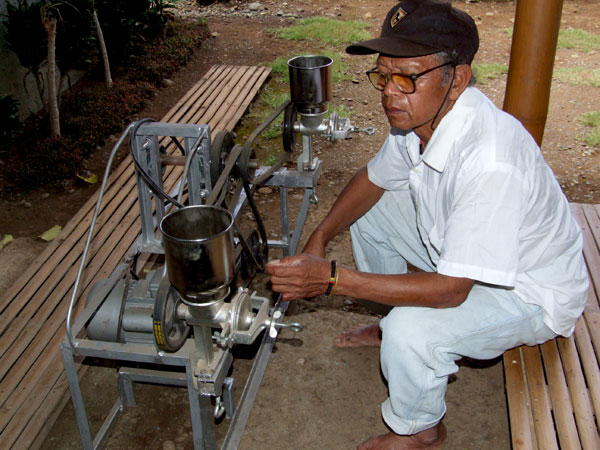
This article looks like just a collection of the practical aspects of Bukidnon life. There is a deeper significance, however, to be observed in many of these practices. These, too, are part of their culture, connected to it through construction of meanings that incorporate them into the greater whole. These traditional practices make use of the resources that spring from the land. Practicing them allows the cultural meanings attached to them to deepen the tribe’s connection to their ancestral domain.
Signs and omens to observe in farming
Basically, the duty of the tribe’s economist (malagbasok) is to divine from the signs in nature so that s/he may be able to predict how life will go. The signs may come from the sun, stars, and moon, water in the rivers and creeks, and other phenomena like the things that may happen on the way to the farm.
For instance, a farmer who plans to start preparing the land to be tilled would first observe things at home. First, he would sharpen his bolo or tools, and if ever he gets wounded he would interpret it as a bad omen. In this case, he may postpone his schedule but he will still observe the same procedure.
Second, in going to the farm site it is considered a bad omen if he or someone else sneezes once. He should go back inside the house for a few minutes before proceeding to the farm. If he or another person sneezes twice, it means he should go fast toward his destination. Three or more sneezes are not a bad omen. It simply means he or another person has cold.
Third, any of these are believed to be bad omens: any snake that shows up along the way or trail, and the sound of a bird called limukun (forest dove). Upon encountering any of these signs, the farmer must do some ritual if he decides to go on or he may postpone his activities.
Fourth, upon his arrival at the proposed farm site and he is about to begin working on one end but hears the sound of a limukun, he should transfer to the other end where he may start. The very first grass he cuts with his bolo should be thrown at his back. If it is a tree, he should do the same with the first piece he cuts. This is to counter all the bad omens.
If the farmer observes none of these omens, he may begin working at once. If he has already countered the bad omens, he may then perform a ritual by offering three chickens to the spirits inhabiting the place, like Talabugta or spirit of the land, Bulalakaw or spirit of the water, and the spirits of the salsalan or blacksmith, the spirits of the trees and many others. He would ask these spirits to watch over the crops and give strength and good health to anybody working on it. He would also promise to give them a share of the harvest.
Farming or ibabasuk invokes the help of the spirits of the salsalan to give strength to the farmer and his tools, and of the talabugta to make the planted crops healthy. The consent of all spirits who have significance to farming would be asked for a successful harvest. Hence the farmer would perform the following customary rituals and practices:
Panalabugta – ritual for the spirit guardian of the land or soil
Pangibabasuk – ritual for the spirit guardian of plants
Talutambu hu Salangsang – ritual for the spirit guardian of food
Kagsad-ang – ritual for the spirit of the place where preserved corn is hanged
Kagbugawan – ritual for the spirit of the container with abundant food
Kagbungkad – ritual asking permission to get food from the container or bugawan
Kagbahin hu mangangalawat – sharing food to others who are needy
In addition to divining from the position of heavenly bodies and signs from the natural world and performing rituals, the farmer also ensures that his methods would mitigate adverse environmental impacts.
For example, farm lots are located far from headwaters in order to protect water sources. A good site is one that has moderate slopes so that felled trees will settle downslope and leave more areas for planting. It also requires less effort in that the farmer bends over less than when he tills a level field.
It should be noted that the traditional farmer does not cut down water-bearing trees when clearing an area for cultivation. This leaves the water table undisturbed and prevents riverbanks from being eroded. During dry periods the farmer cuts down the trunks of these trees to water his crops. These trees will still survive because they regenerate fast through their new branches.
The site’s vegetation tells the farmer what crops are best suited. Lauan trees indicate fertile loam soil which is ideal for abaca, corn and coffee. If the dominant species are olayan (Philippine oak) and giyung (tiger grass) it suggests poor reddish soil. Here only sweet potatoes and other crops that require lesser nutrients will thrive.
Other trees, shrubs and plants that have economic, ecological and medicinal uses are also preserved. Some of these are sources of nectar for honey, an important livelihood commodity. Others bear fruit on which wild pigs forage. Their abundance would keep these animals from ravaging agricultural crops.
Making of farm implements
Salsalan enables the tribe to make tools for their farm work like bolos which are used for weeding, planting and other activities. The blacksmith shop is sacred since it has guardian spirits from whom they ask assistance but who may punish erring humans through illness. There are many of these spirits. Considered by the tribe as their brothers, they dwell in the forests and mountains, and one of them holds the lamp of life of every person. The tribe takes care not to violate the omens of salsalan based on customs and traditions.
The skills needed for working in the salsalan have been passed on from generation to generation, from Datu Mapanglaw to Datu Manbinang, Datu Man Docenos, Datu Pio Docenos, Datu Makaatul, and now Datu Dumapal, the eldest of Datu Makaatul, as well as to Bai Malugdang, Datu Pagalungan, Bai Inatlawan, Datu Makaantuk, Bai Mananawal, Bai Makabat-aw, the youngest, and her son Vicente Docenos who is also a good blacksmith as a datu.
Different Kinds of Crops
Among the crops of the tribe are camote or sweet potato, gabi, binggala or cassava, kamais, patad and arurut. They regularly plant these crops throughout all seasons in Mount Kitanglad, part of which is their ancestral domain. Since rice would not bear grains in the forest due to the cool climate, they have to rely on these foods for their sustenance.
The tribe would eat edible grasses like paku and hagpa, wild animals like pig and deer, and other indigenous foodstuffs found in the forest. This explains why the tribe takes good care of the domain because it supplies their need.
Money comes from weaving mats, bags, winnowers, and other crafts out of sudsud and rattan. Coffee beans and abaca fiber used to be sold in Kagay-an (Cagayan de Oro City), formerly called Lambaguhan. But since it is far they rarely had money. (This article is based on an earlier research done by the author.)
